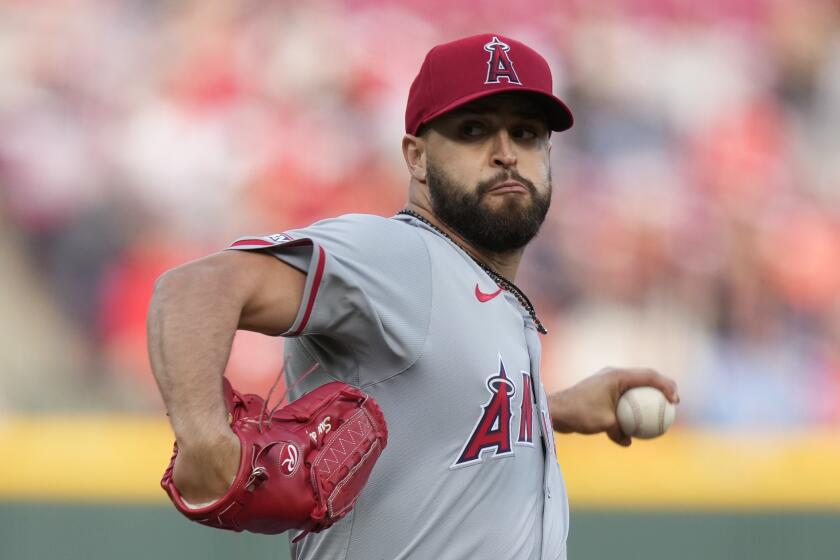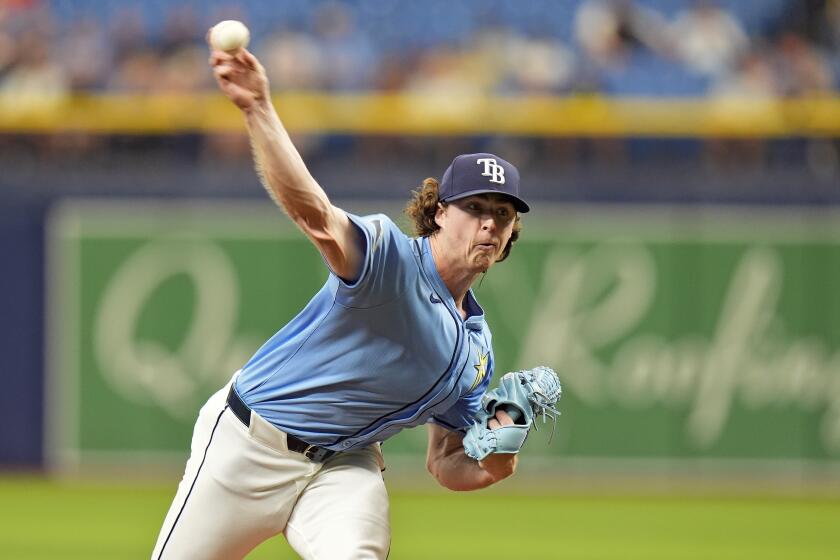League of Extraordinary Men
The headline is a stopper:
“Angels Clout Nine Homers, Win 22-5.”
It was June 22, 1957, and Roger Osenbaugh still remembers every pitch. He should. He was the opposing pitcher.
“It’s the best memory I have,” he said of the game between the Sacramento Solons and the Los Angeles Angels at Wrigley Field, which stood at 42nd Street and Avalon Boulevard and was the West Coast copy of the Chicago Cubs’ home.
“Twenty-two runs, 18 earned runs, nine home runs, five home runs in one inning,” he recalled.
Mercifully, it was the second game of a doubleheader, which meant it lasted only seven innings. Despite giving up those 22 runs, Osenbaugh’s earned-run average that season was 4.36.
Why he stayed in that game, and is proud of it, lies at the heart of the old Pacific Coast League.
New Game in Town
Long before the Los Angeles Angels of Anaheim went to court over their name, the Angels of the old PCL brought professional baseball to Los Angeles.
The league was formed in 1903 but didn’t hit its stride until after World War II, growing in popularity as fast as California was growing in population. In 1947, the Angels hit a high mark in paid attendance -- 622,485.
By 1919, there were the Angels, Solons, Oakland Oaks, San Francisco Seals, Seattle Indians (later Rainiers), Vernon Tigers and Portland Beavers. The Hollywood Stars joined in 1926 before moving to San Diego 10 years later to become the Padres.
The Tigers moved to San Francisco as the Mission Reds, then returned to L.A. in 1938 to become the new Hollywood Stars, who took Tinseltown by storm. On any given day at Gilmore Field, in the Fairfax district, one could find the likes of George Raft, Gary Cooper and Barbara Stanwyck.
First baseman Chuck Stevens, who played for the St. Louis Browns, joined the Stars at the tail end of the 1948 season.
“When you played on the Stars,” he said, “every day was lollipop day because you’re liable to be walking by the batting cage and somebody would say, ‘Hello, Chuck.’ And you’d say to yourself, ‘Gee, that voice is familiar.’ And it’s liable to be Groucho Marx or Phil Silvers.”
But more often than not, the real stars of the PCL were the Angels, who won 12 pennants from 1903 through 1957.
Stevens, now 87, still marvels at the caliber of players, particularly the 1934 Angels.
“There were guys hitting .340, .350 -- almost every one of them did that year,” he said. “Pitching was phenomenal. It was a sight to see. They absolutely slaughtered the rest of the league.”
Having grown up in Long Beach, watching the Angels at Wrigley Field in 1934 was a regular event for Stevens.
“It was like a dream,” he said. “If you lived in Southern California, you automatically became an Angels fan.”
That 1934 team was 137-50 (.733). A partial roster: Right fielder Frank Demaree, who won the PCL triple crown and most-valuable-player honors that year (45 homers, 173 runs batted in and a .383 batting average), center fielder Jigger Statz (13 triples, .324 and 61 stolen bases) and three 20-game winners.
The 1956 Angels were as good. They won the pennant with a 107-61 record. Leading them was the powerful and popular Steve Bilko. He too won the triple crown and was MVP (.360, 55 homers and 164 RBIs).
There were plenty of future major league Hall of Famers in the PCL, including Joe DiMaggio (Seals), Ted Williams (Padres), Bob Lemon (Rainiers), Bobby Doerr (Stars) and Ernie Lombardi (Oaks) -- all Californians.
Why was the PCL such a lure?
“One word,” said Dick Beverage, president of the Assn. of Professional Baseball Players of America. “Geography.”
California historian Kevin Starr would agree.
“The Pacific Coast League -- like Hollywood, like the Golden Gate Bridge, like the University of California and the Bank of America -- was one of California’s best ideas of itself before the 1950s,” he said. “This was an era in which California came of age on its own terms, with a high degree of autonomy.
“In many ways -- the loyalty of its fans, the champions it produced, the successful connections to their cities -- the Pacific Coast League was more than a minor league. It was a semi-major league, paralleling the major leagues on the East Coast.
“The argument could be made that the arrival of the Dodgers and Giants ... represented as much a re-colonization of California as it did an upgrading of its professional baseball culture.”
Except for the Angels, whose owner was the Cubs’ Philip Wrigley and later his Santa Catalina Island Co., every team was independently owned and operated, Beverage said. That was important to players, who would otherwise belong to the whims of major league clubs.
Plus, the pay was good.
Osenbaugh’s real-life example: “In 1952, I had five or six offers. The top major league offer was a $2,500 bonus. The Solons offered $2,000 but they would also pay my tuition to graduate school. And they sweetened it with a five-year clause that precluded my purchase by a big-league club without my consent. If I did agree to a sale, I’d get 15% of the sales price.”
Travel was first-class plane rides to most road games and players stayed at the best hotels.
“Also remember, the Coast League was one step above triple A and half a step below the majors,” Osenbaugh said.
Stevens remembers a double brawl at an Angel-Star doubleheader in 1953. As he recalls it, two fights broke out in the first game. By the break, police were there and players not in the second game were confined to the clubhouse. “Those two fights probably lasted only a few minutes but it felt like two or three weeks,” he said.
Stevens’ daughter, Randall, was there that day. But her most vivid memory is having to wear dresses to the ballgame. “That’s the way it was,” she said. “Looking back, though, it was an awfully special time.”
Badge of Honor
Special is what Osenbaugh defined that day in 1957 when he gave up all those runs.
As he explains it, he was just out of the hospital after recovering from an infection when Manager Tommy Heath told him the team was in trouble. Could he pitch the next day? Osenbaugh didn’t flinch.
“That was the mental makeup of the players in those days,” he said. “It was a dishonor to come out of a game. After six innings, I was behind, 11-5, and Tommy says, ‘We better get you out of there.’ I said, ‘Look, the pitching staff is shot, the game is probably shot, let me stagger through.’ Then the roof caved in.”
Osenbaugh, now 75, a former member of the state’s coastal commission and a successful executive, said his one regret is having left baseball in his prime, eager to put his MBA to work.
“It wasn’t until years went by that I realized what I had given up,” he said. “Outside of family, playing in the Coast League is the fondest memory I have in life.”
That ’57 game? No regrets. One of the nine homers was by a kid, Georgie Anderson. Osenbaugh, his voice cracked with emotion, said years later Anderson told him, “Every spring training I tell my players about that bad game you had in L.A. That was the greatest act of courage I’ve ever seen on a ball field.”
By then, Anderson was better known by his nickname: Sparky.
*
(BEGIN TEXT OF INFOBOX)
PCL top 10
In conjunction with the Pacific Coast League’s centennial in 2003, a panel of minor league experts selected the league’s 10 best teams of all time:
* 1. 1934 Los Angeles Angels (137-50)
The Angels dominated the league in all categories, led by Frank Demaree, who won the triple crown with 45 home runs, 173 runs batted in and a .383 batting average, and pitchers Fay Thomas (28-4), Lou Garland (21-9), Emile Meola (20-5) and Whitey Campbell (19-15).
* 2. 1925 San Francisco Seals (128-71)
Paul Waner, a future Hall of Famer with Pittsburgh, led the way with a .401 batting average and 74 doubles. The Seals won a postseason playoff with Louisville for the Class AA championship.
* 3. 1981 Albuquerque Dukes (94-38)
Leading this Dodger farm team to the second-best winning percentage (.712) in league history was first baseman Mike Marshall, who won the triple crown with 34 home runs, 137 runs batted in and a .373 batting average.
* 4. 1943 Los Angeles Angels (110-45)
Despite putting together a 21-game unbeaten streak during the season, the Angels didn’t win the league championship, getting swept by Seattle in the first round of the playoffs.
* 5. 1903 Los Angeles Angels (133-78)
In the PCL’s first season, the Angels won their first 15 games, then kept on winning. Manager and first baseman Frank Dillon led the league with 274 hits, and his team was far enough ahead that he was able to take time off late in the season to get married and go on a honeymoon.
* 6. 1906 Portland Beavers (114-58)
Elmer Califf pitched 40 complete games and had a 34-14 record for the Beavers, despite a season shortened as a result of the San Francisco earthquake.
* 7. 1970 Hawaii Islanders (98-48)
Playing in a popular destination for other PCL teams, this Angel farm team was a rude host. Utility player Winston Llenas batted .339 and second baseman Doug Griffin hit .326, and Dennis Bennett won 18 games.
* 8. 1922 San Francisco Seals (127-72)
A trio of 20-game winners led the Seals to the title: Jim “Death Valley” Scott, at 25-9, Ollie Mitchell (24-7) and Bob Geary (20-9)
* 9. 1928 San Francisco Seals (120-71)
The team’s batting average was .308, and the Seals also led the league in runs (1,129), hits (2,059) and home runs (182).
* 10. 1909 San Francisco Seals (132-80)
The Seals played 212 games on the way to claiming the organization’s first championship. Led at the plate by right fielder Henry Melchoir, whose .298 average was good enough to lead the league in the deadball era, and left fielder Ping Bodie, with 10 home runs.
Sources: www.coastleague.com
www.pclbaseball.com
More to Read
Go beyond the scoreboard
Get the latest on L.A.'s teams in the daily Sports Report newsletter.
You may occasionally receive promotional content from the Los Angeles Times.




